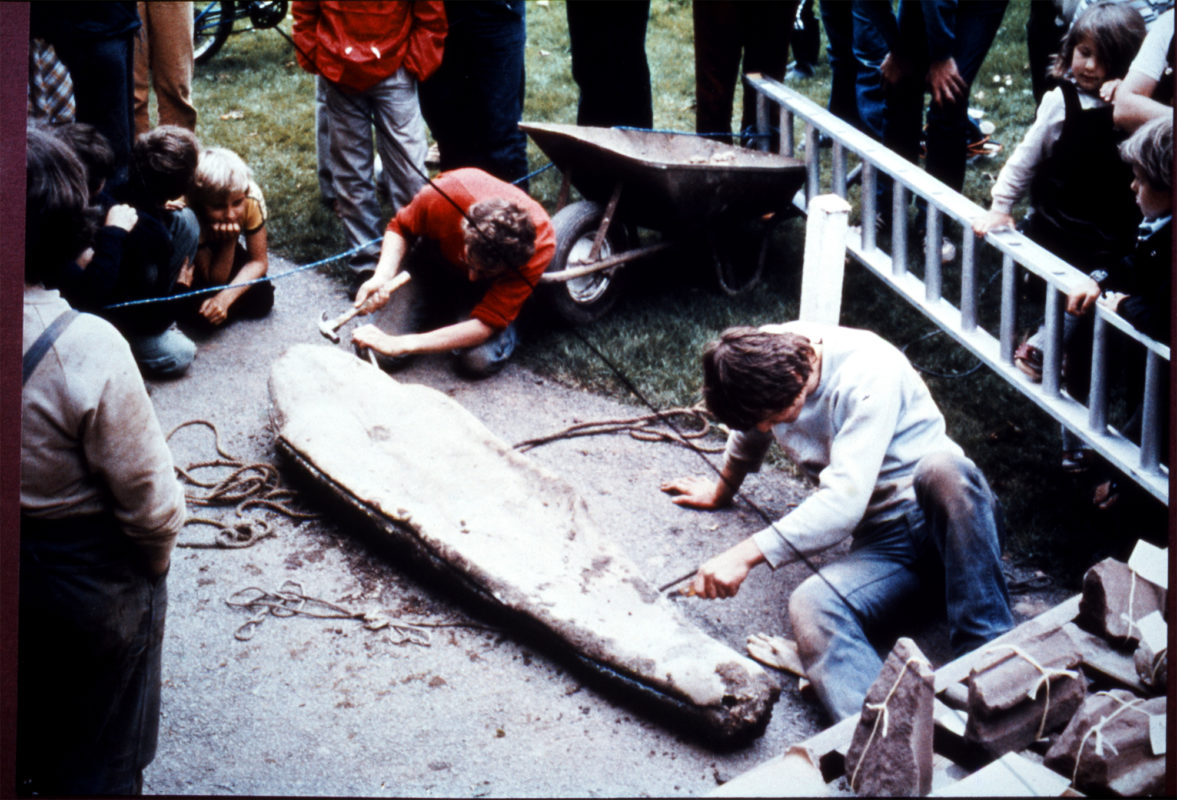This linen shroud once covered the body of a medieval nobleman who was found so well preserved that he still had his eyes.

In 1981, archaeologists were excavating here at the 12th-century St Bees Priory Church in the village of St Bees in Cumbria, England, when they made a remarkable discovery. In the ruined chancel aisle (then a car park), they found a wooden coffin wrapped in a lead sheet. Inside was a remarkable well preserved body of a man who had died over 600 years earlier (c. 1368). He was subsequently named “St Bees Man.”

The face of St Bees Man (Anthony de Lucy?).
The body is accepted to be that of Anthony de Lucy, 3rd Baron Lucy, not to be confused with his well-known grandfather Anthony de Lucy, 1st Baron Lucy (1283–1343), who was warden of Carlisle Castle and fought at the battle of Bannockburn in 1314.

An autopsy was performed, which revealed that all the organs were still intact and, with the exception of the brain, all in remarkable condition. The body looked like that of someone who had died a few weeks ago, not over 600 years ago. Equally surprising was the liquid blood still present in the chest cavity, and his last meal (possibly porridge and raisins) still in his stomach.

The eyes of St Bees Man.
The body’s preservation was due to a combination of the lead sheath and pine resin coated shrouds. The lead excluded moisture while the pine resin prevents air reaching the body, creating an environment in which bacteria cannot thrive. According to the late Dr John Todd:

“Under such conditions, hydrolysis of the neutral fats of the body tissues took place, changing them to fatty acids which were deposited as crystals in the tissues. These chemical changes acidified and dehydrated the tissues, so killing off the bacteria which normally cause decay, and producing glycerol which acts as a preservative.”
Cause of death was considered to be a hemothorax, which had been caused by a broken rib puncturing his lung, possibly sustained while he was fighting in battle. His jaw was also broken in two places.

Part of the shroud that covered his face.
After the autopsy had been performed, St Bees Man was reburied where he had been found.
Another skeleton, that of a female, was found alongside St Bees Man. It is believed to be his sister, Maud de Lucy.
If you want to see the face of St Bees Man, look no further than the comment section. There will also be a link to a detailed article on the subject and more photos.
News
Stephen Curry offered Ayesha Curry a single dish on their first date that made Ayesha agree to be his wife.
With Ayesha Curry, go down memory lane via food, of course! Curry tells people in this week’s issue that she is constantly creating new recipes, whether they are for her family’s dinners or her new cookbook, The Full Plate. She…
Stephen Curry: From an underrated boy to an icon of world basketball
Stephen Curry, the Golden State Warriors’ superstar, has had an extraordinary journey in the NBA, going from an unknown player to solidifying his place as the Greatest of All Time (GOAT). His rise to greatness is a testament to his…
Rick Ross’ strange and eccentric hobbies make his relatives become distant.
Rick Ross, the renowned rapper and entrepreneur, has a rather unconventional hobby that sets him apart from the crowd: he keeps wild animals as pets. While many celebrities opt for more traditional pets like dogs or cats, Ross has embraced…
Lil Wayne revealed the reason why he always loves and pampers Kameron the most compared to his other children.
The bond between a parent and child is one of the most profound and enduring relationships in life. For Lil Wayne, the renowned rapper and father of four, his love for his youngest son, Kameron, runs deep. As Kameron grows…
Lil Wayne reveals his songwriting formula for creating explosive and successful rap songs.
Onе of thе most succеssful rаppеrs of thе lаst two dеcаdеs is Lil Wаynе. Sincе rеlеаsing his first аlbum аt 17, hе hаs sold oᴠеr 120 million copiеs worldwidе, mаking him onе of thе most succеssful аrtists in hip hop…
Novak Djokovic dressed as Snoop Dogg – passionately singing with Eminem at a cozy party, making fans excited.
Novak Djokovic made an impression on his rivals in Monte Carlo after his performance at the player party. The world No. 1 dressed up as Snoop Dogg and danced to one of his songs before rapping Eminem. All of it…
End of content
No more pages to load











